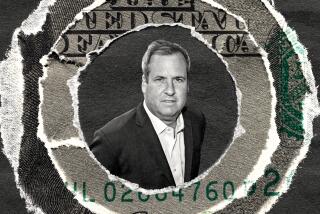Investment Bank Barrington Fills Middle-Market Niche
- Share via
It was 1990, and Southern California’s aerospace recession was biting down hard -- the region’s first major business slump in a decade. Jim Freedman and his partners at regional investment banking firm Barrington Associates watched as their big East Coast counterparts packed up their L.A. outposts and left California, like refugees fleeing a famine zone.
“Those were tough times,” Freedman recalled recently in his Westside office. “We decided it was a great time to build.”
The decision helped turn Barrington into what today may well be this region’s premier mergers and acquisitions advisor for businesses with annual revenue of $20 million to $500 million -- so-called middle-market companies.
Listening to Freedman and his partners describe their role in a local economy characterized by small and medium-sized entrepreneurs is a little like hearing venture capitalists in the Bay Area talk about their place in a symbiotic world of high-tech wizards and financial specialists: They exist to serve a business community with peculiar characteristics.
Southern California isn’t as technology-driven as Silicon Valley, of course, but its legions of middle-market companies do in fact need specialized advice. They also need access to investors that can’t easily be obtained from giant investment banks with expensive overhead and the distractions of a global clientele.
Freedman, 51, says he sensed this soon after graduating from UCLA’s Anderson School of Management in 1978. He founded Barrington four years later.
“I saw L.A. as a fertile area for middle-market companies,” he explains, “without a strong advisor” tailored to their needs.
The only sources for such advice at the time were a small cadre of local investment banks such as Bateman Eichler, Hill Richards; Sutro & Co.; and Morgan, Olmstead, Kennedy & Gardner. But these firms, which also tended to function as regional brokerages, were soon to be consigned to history -- swallowed up by big banks or bigger investment houses in a spurt of financial-services consolidation.
Freedman also recognized that many potential clients happened to have reached the moment in life when his counsel was likely to be most in demand.
These people had founded small manufacturing concerns in the postwar years, nurturing them over three decades, and were now ready to retire. Barrington’s typical client was a businessman in his mid-60s looking for what bankers call a “liquidity event” -- a way to cash out. Barrington’s niche specialty was in selling these companies, often to competitors.
Still, a niche is a niche. After Barrington was launched, clients were so scarce that Freedman applied to a Westside restaurant for a night job waiting tables. He got the job, but one of his deals closed in the nick of time, saving him from having to hoist a tray. By 1985, when Freedman added a partner, Barrington was handling two or three deals a year.
The flow soon picked up even more. In 1988 came the sale for more than $100 million of Woodland Hills-based Applause Inc., a leading maker of plush toys, to the Thompson family, best known as the owners of the
7-Eleven retail chain. The firm’s highest-profile transaction, the $114-million sale of the Los Angeles Kings hockey team to Philip Anschutz and Edward Roski Jr., followed in 1995.
“That was quite a complicated deal,” says Joseph M. Cohen, who with his partner Jeffrey Sudikoff was the seller. Cohen and Sudikoff had retained Barrington to help complete their purchase of a majority stake in the Kings from Bruce McNall a little more than a year earlier. McNall, who remained a minority partner in the franchise, soon went bankrupt. So the sale to Anschutz and Roski had to be cleared by his bankruptcy trustee. Meanwhile, the National Hockey League was looking over the principals’ shoulders, as were a press and public that had been watching in frustration as the team struggled through financial problems.
Roski had been a client of Freedman’s, who accordingly was aware of his interest in building a new L.A. sports arena with Anschutz. “We knew that if we could deliver the Kings, they’d have a tenant for their arena,” Freedman recalls. Although their interest initially focused on a parcel they owned near Union Station, the Kings sale ultimately resulted in their construction of Staples Center across town.
Over the years, the nature of the typical Barrington client has changed, reflecting the evolution of the regional entrepreneurial economy.
“In the old times, it might take 25 or 30 years to build a business to a point where you could sell it to someone,” says W. Michael Rosenberg, the partner who joined in 1985. “Now you can grow much more quickly.” The firm’s typical client is in his mid-40s today -- still young enough to start another venture or two before hanging it up.
In February, Barrington kicked off the most ambitious venture in its 22-year history -- the establishment of Shanghai-based Barrington Asia Pacific to cement ties with the Far Eastern investment community.
“We know we’re a little early,” Freedman says, “but we’re the only investment bank of our size doing this right now.”
He adds that he’s not fazed by the political dust likely to be stirred up by Asian investments in domestic companies or domestic attempts to cut costs by operating in Asia. “Whether we like it or not, it’s happening,” he says. “We can be prepared for the implications, but it’s not going to stop.”
That said, the firm’s focus remains Southern California.
Around the same time it established its Asian arm, Barrington recruited as a managing director Stephen Koffler, a 62-year-old Los Angeles investment banker whose experience -- and Rolodex -- Freedman had long coveted. (Koffler’s own boutique firm won fame in 2002 for engineering the leveraged buyout of Jenny Craig Inc. for $120 million -- a deal that in this LBO-starved period gave Koffler & Co. the No. 2 ranking for LBOs nationwide, trailing only Merrill Lynch & Co.)
Barrington’s biggest transaction remains the 2002 sale of Herbalife International Inc. to a pair of private equity firms for $685 million. But far smaller transactions remain its lifeblood, as it churns out 20 to 25 deals a year.
“I could tell they had many larger clients, but they didn’t turn our business away,” says Michael McCourt, whose 2002 sale of his Santa Fe Springs-based Sharpe Manufacturing Co. was handled by Barrington. The third-generation manufacturer of industrial paint-spraying equipment, with annual revenue of $15 million, was being squeezed by rivals in Europe and Asia when it asked Barrington to help find an exit strategy.
When it came time to negotiate with the prospective buyer, Graco Inc., Freedman handled the negotiating personally. “We did way better than we expected,” McCourt says.
Freedman says this level of service is what keeps clients coming back; little entrepreneurs often have a way of becoming bigger entrepreneurs, after all.
It also helps Barrington fend of the periodic incursion of East Coast investment firms, which sustain themselves during downturns in big-bucks M&A; activity by moving into the sub-$100-million deal market and trying to elbow firms like Barrington aside. But when their traditional business revives, Freedman says, they often leave these clients in the lurch. That’s part of his pitch.
“We identify with the entrepreneurs,” he says, “because we’ve been in the same place.”
Golden State appears every Monday and Thursday. You
can reach Michael Hiltzik at [email protected] and read his previous columns at latimes.com/hiltzik.
More to Read
Inside the business of entertainment
The Wide Shot brings you news, analysis and insights on everything from streaming wars to production — and what it all means for the future.
You may occasionally receive promotional content from the Los Angeles Times.











